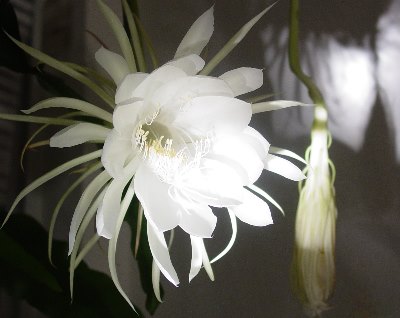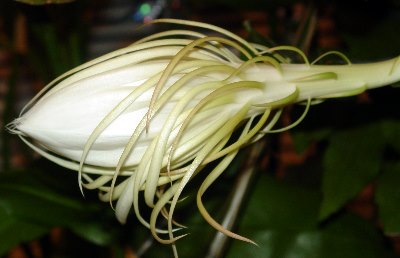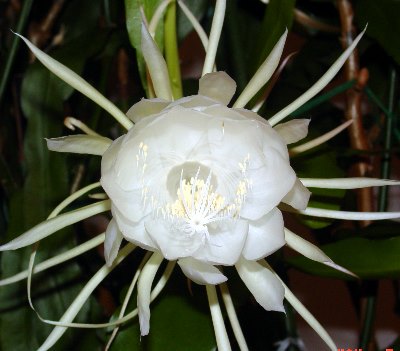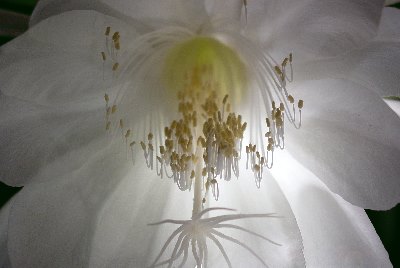 Night-Blooming Cereus are one of the most breathtaking flowers in existence. There are few blossoms in the world that are as large, as fragrant, as heavenly. Conversely, there are few flowers that are as short-lived. Night-Blooming Cereus are one of the most breathtaking flowers in existence. There are few blossoms in the world that are as large, as fragrant, as heavenly. Conversely, there are few flowers that are as short-lived.
Individual flowers, that can span 10" across, last approximately 6 hours from the cracking of the bud to the finish, before dawn, when the magnificent blossom expires. The reason few people have seen these blooms is probably because they bloom at such inconvenient times, the middle of the night. The blooms do not typically begin opening til midnight. Early to bed, early to rise people will never enjoy this nocturnal delight. They bloom in your sleep.
In Asia, they are called "The Flowers of Tang", and because of the rarity of their blooming, frequently a party is called and everyone available is invited over to celebrate and watch the magnificent flowers and celebrate the uniqueness of the event.
I have also seen it called "Queen of the Night". It is indeed that... and lucky is the person to stumble upon it in the wild, by the light of the moon, where the snow white fragrant petals must beckon like a glowing, fragrant reflection of the orb above. But it is only fully open for an hour, so only the dedicated, determined, or very very lucky can ever see it.
Epiphyllum oxypetalum is in the cacti family and can grow to 10' tall. The plants are almost ugly, they have thin spindly green leaves about 2" wide and very flat, with a large stem running through the center. While it is a succulent, it is unlike any succulent I have ever seen... it appears ever starved for water, even when fully healthy. With stems and leaves only 2" thick, it is a marvel to see the enormous 7-10" flowers when they bloom. A juxtaposition of opposites... the larger than life beauty, on the nondescript background. The plant alone does not give even a small hint of its hidden potential.
The plants appear to be able to bloom 2 or more times a year under perfect conditions, all opening in 1 or the next night. In less than optimal conditions, it may be years between a single blooming. When this occurs, the opened buds will be gone over a 6 hour span. Thus, they are a signal for a gathering, or party, because it is a singular event, even if only for 1 blossom.
 My mother happens to have a large specimen plant of this incredible species, hers is approaching 7' in height, but bushy. The thin spindly leaves must be staked, because they are incapable of supporting the weight of the enormous flowers on their own. In nature, the plant likely grows on trees, supported by massive trunks. She has had bloomings of as many as 20 flowers in one night, a great rarity indeed. The plant is easily propagated from cuttings, but it takes many years to bloom from cuttings, arguably worth the time investment. My mother happens to have a large specimen plant of this incredible species, hers is approaching 7' in height, but bushy. The thin spindly leaves must be staked, because they are incapable of supporting the weight of the enormous flowers on their own. In nature, the plant likely grows on trees, supported by massive trunks. She has had bloomings of as many as 20 flowers in one night, a great rarity indeed. The plant is easily propagated from cuttings, but it takes many years to bloom from cuttings, arguably worth the time investment.
 I have stayed awake many a night photographing the blooms and reveling in their mystery and fragrance. Here is how they bloom. I have stayed awake many a night photographing the blooms and reveling in their mystery and fragrance. Here is how they bloom.
This bud is about to open. The buds increase in size to around 4-5", and become paler when they are ready to bloom that night.
You can literally observe the bud opening before your eye.
Because the flowers open, close and are spent in one night, the opening sequence occurs very quickly, relative to other flowers.
 As you watch, the flowers move from the energy of opening, as if they were living things, almost pulsing with breath. As you watch, the flowers move from the energy of opening, as if they were living things, almost pulsing with breath.
Within the petals, you begin to see the lovely mass of stamens and over-large pistil. As it blooms, the contents inside are so compressed that they appear to burst, pushing the petals outwards like the iris of your eye.
The buds usually begin popping at either at 9pm or 12pm and are fully open 3 hours later.
They are always spent and finished by 6am. Fully open, they are at their most fragrant, and range in size from 7" to 10" in diameter, including the long, lovely, spidery sepals.
 The fragrance is unbelievable. Even 1 flower would fill a house with scent. The fragrance is unbelievable. Even 1 flower would fill a house with scent.
When I was asked to describe the scent, I had to say that it was most like an orange blossom or jasmine, with just a hint of vanilla and maybe black pepper.
It is not oily like a gardenia or magnolia, or astringent like ylang. It is probably the purest 'flower' scent I can imagine. Perhaps this is also due to the fact that the flower is right there, and the visual magnificence influences your sense of smell.
It is unfortunate, and perhaps ironic, that it only blooms at night when most people are asleep and dreaming. Or perhaps it is fitting.
 Imagine coming upon this plant blooming in the wild. It would be an ethereal otherworldly experience never to be forgotten. Masses of these flowers in bloom, by the light of the moon... almost unimaginable. Imagine coming upon this plant blooming in the wild. It would be an ethereal otherworldly experience never to be forgotten. Masses of these flowers in bloom, by the light of the moon... almost unimaginable.
The inside of the flower, after the petals begin to open, is even more amazing than the outside. It looks almost alive.
In it's full glory, the flowers dangle, too heavy for the leggy stems that bear them. Eventually, the buds that were higher begin to droop lower and lower until it looks like their weight can no longer be supported by the thin plant they belong to.
 Like alighting butterflies, you expect them to burst free of the plant. Like alighting butterflies, you expect them to burst free of the plant.
Of course they don't. They stay there until they are spent... and then, the remains dangle like long, deflated cocoons. There, behind the 2 open blossoms in this last image, is a spent flower from the night before. An unusual multi-night blooming provided this particular shot, and in it, you see the life and death of the individual flowers.
I am hoping that I can perhaps capture some of the scent essence of the flowers at the next blooming. The scent, if it can be captured, would be unlike almost any other flower, as unique as the flower itself is. The best description I can give of the scent, is if in your dreams you could smell the most ideal scent for a flower ... this would be it.
Any suggestions on tincturing would be welcome. I will post the experiments and results on this page as I can.
Thanks for looking!
Helen
1/7/07
I wrote this for Juanita at the NaturalPerfumery Yahoo Group, who would like to know more.
©All Images and text
Copyright ZenSoaps 2007. All Rights Reserved. No part of this page may be reproduced without express written permission.
|